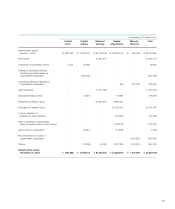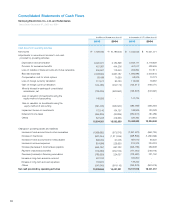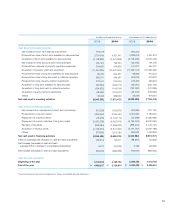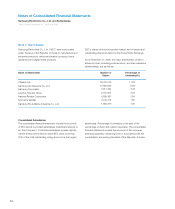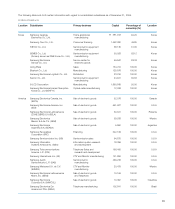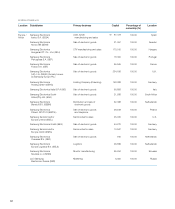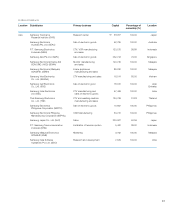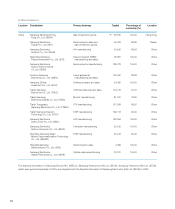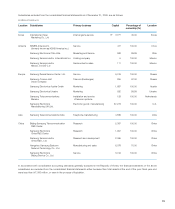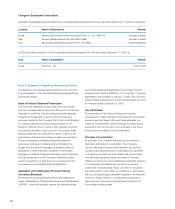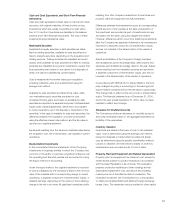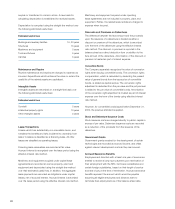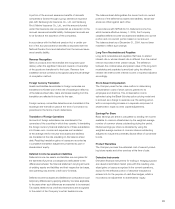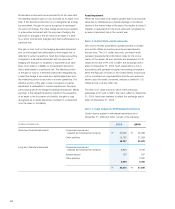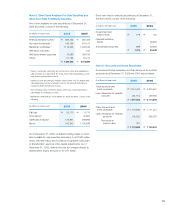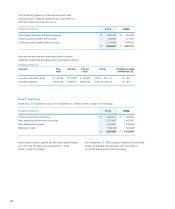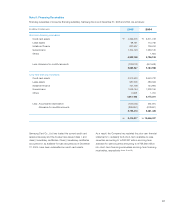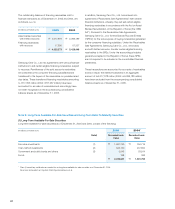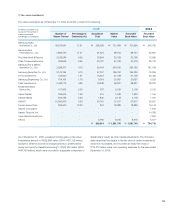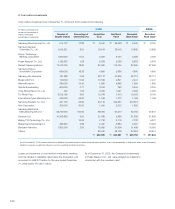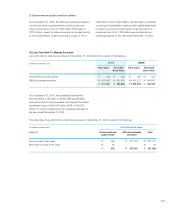Samsung 2005 Annual Report Download - page 93
Download and view the complete annual report
Please find page 93 of the 2005 Samsung annual report below. You can navigate through the pages in the report by either clicking on the pages listed below, or by using the keyword search tool below to find specific information within the annual report.91
Cash and Cash Equivalents, and Short-Term Financial
Instruments
Cash and cash equivalents include cash on hand and in bank
accounts, with original maturities of three months or less.
Investments which are readily convertible into cash within
four to 12 months of purchase are classified in the balance
sheet as short-term financial instruments. The cost of these
investments approximates fair value.
Marketable Securities
Investments in equity securities or debt securities are classi-
fied into trading securities, available-for-sale securities and
held-to-maturity securities, depending on the acquisition and
holding purpose. Trading securities are classified as current
assets; while available-for-sale securities and held-to-maturity
securities are classified as long-term investments, except that
those securities that mature or are certain to be disposed of
within one year are classified as current assets.
Cost is measured at the market value upon acquisition,
including incidental costs, and is determined using the
average cost method.
Available-for-sale securities are stated at fair value, while
non-marketable equity securities are stated at cost.
Unrealized holding gains and losses on available-for-sale
securities are reported in a separate component of shareholders’
equity under capital adjustments, which are to be included
in current operations upon the disposal or impairment of the
securities. In the case of available-for-sale debt securities, the
difference between the acquisition cost after amortization,
using the effective interest rate method, and the fair value is
reported as a capital adjustment.
Impairment resulting from the decline in realizable value below
the acquisition cost, net of amortization, are included in current
operations.
Equity-Method Investments
In the consolidated financial statements of the Company,
investments in business entities in which the Company has
a control or the ability to exercise a significant influence over
the operating and financial policies are accounted for using
the equity method of accounting.
Under the equity method, the original investment is recorded
at cost and adjusted by the Company’s share in the net book
value of the investee with a corresponding charge to current
operations, a separate component of shareholders’ equity, or
retained earnings, depending on the nature of the underlying
change in the net book value. All significant unrealized profits
resulting from inter company transactions of inventories and
property, plant and equipment are fully eliminated.
Differences between the investment account and corresponding
capital account of the investee at the date of acquisition of
the investment are recorded as part of investments and are
amortized over five years using the straight-line method.
However, differences which occur from additional investments
after the Company has significant influence in its investees are
reported in a separate component of shareholders’ equity,
and are not included in the determination of the results of
operations.
Assets and liabilities of the Company’s foreign investees
are translated at current exchange rates, while income and
expenses are translated at average rates for the year. Adjust-
ments resulting from the translation process are reported in
a separate component of shareholders’ equity, and are not
included in the determination of the results of operations.
In accordance with SKFAS No.15, Equity Method, the Com-
pany changed its policy in accounting for the earnings from
equity-method investments from the net basis to gross basis.
This change had no effect on the net income or shareholders’
equity. The financial statements as of December 31, 2004,
and for the year ended December 31, 2004, have not been
restated to reflect such change.
Allowance for Doubtful Accounts
The Company provides an allowance for doubtful accounts
and notes receivable based on the aggregate estimated col-
lectibility of the receivables.
Inventory Valuation
Inventories are stated at the lower of cost or net realizable
value. Cost is determined using the average cost method,
except for materials-in-transit which are stated at actual
cost as determined using the specific identification method.
Losses on valuation of inventories and losses on inventory
obsolescence are recorded as part of cost of sales.
Property, Plant and Equipment and Related Depreciation
Property, plant and equipment are stated at cost, except for
certain assets subject to upward revaluation in accordance
with the Asset Revaluation Law of Korea. The revaluation
presents production facilities and other buildings at their
depreciated replacement cost, and land at the prevailing
market price, as of the effective date of revaluation. The
revaluation increment, net of revaluation tax, is first applied
to offset accumulated deficit and deferred foreign exchange
losses, if any. The remainder may be credited to other capital


